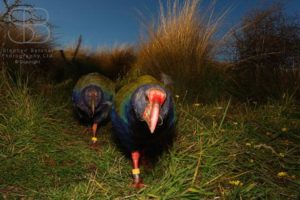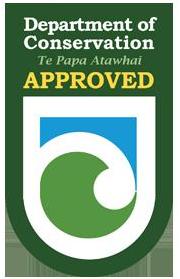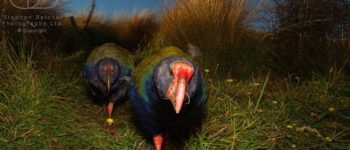1948: Notornis, I Presume?
November 17, 2020
By AHNZ
 Today in history, 20 November, 1948, Dr Geoffrey Orbell set out on a private expedition to find the notornis (takehe) presumed extinct since 1898°. By finding two near Lake Te Anau¹, he proved they were still very much alive. This same year, some 400 birds were found alive and well and anonymous to we humans.
Today in history, 20 November, 1948, Dr Geoffrey Orbell set out on a private expedition to find the notornis (takehe) presumed extinct since 1898°. By finding two near Lake Te Anau¹, he proved they were still very much alive. This same year, some 400 birds were found alive and well and anonymous to we humans.
“”It’s either a damn big swampy [pukeko], or it’s it” whispered Dr Geoffrey Orbell as one of New Zealand’s greatest wildlife stories emerged from behind a tussock on this day in 1948 – the “extinct” takahē, alive in the Murchison Mountains.”- Te Papa; Facebook 2016
 Ever since, the State has been in control of the bird and has expended treasure untold on their welfare program. By the early 1980s The Government had killed 75% of the remaining birds (400) and only now, 40 years later, has the population recovered (c.418.)
Ever since, the State has been in control of the bird and has expended treasure untold on their welfare program. By the early 1980s The Government had killed 75% of the remaining birds (400) and only now, 40 years later, has the population recovered (c.418.)
On one recent occasion, the Department of Conservation not only had 4 notornis under their protection shot but went on to spin the press that it was the fault of a private association! They blamed the Deerstalkers association rather than take responsibility…
“Members from the Deerstalkers Association have shot four critically endangered takahe while carrying out a cull of pukeko on Motutapu Island in the Hauraki Gulf.”
“In 2008 a takahe was shot on Mana Island, off the coast near Wellington, by a Conservation Department worker who also mistook it for a pukeko.”- Critically endangered takahe shot in case of mistaken identity; Stuff (2015)
Three takahē died following 1080 drop in Kahurangi National Park, Stuff (2020)
With friends like the government, who needs enemies!? It’s interesting to note that The State makes their expensive protection programme look successful only by publishing their recent data. If they extended the time series a bit it would show they’re not “flying high” but just breaking even.
They refer to this as “years of refinement” but it’s dubious that government, even after all this time, is helping the bird’s population recover at all and isn’t just running on the spot…
“It’s only in the last decade that DOC really mastered breeding takahē, though the success is based on years of refinements…..50,000 hectares of the Murchison mountains were declared off limits to the public in 1949 – a rule still in place today..”- Takahē: Back from the brink; Stuff (2018)
“Today takahē are classified as Nationally Vulnerable, with a population of just over 400 birds. DOC’s dedicated Takahē Recovery Programme is working hard to grow this number”- doc.govt.nz (2020)
“Takahē may be flightless but their population is flying high with the official count reaching 418 after a record breeding season that produced an estimated 65 juveniles, the Minister of Conservation Eugenie Sage announced today.”- Takahē population flying high; doc.govt.nz (2019)
“…the takahē population was at 400 before it was reduced to 118 in 1982…”- South Island takahē; Wiki
“In that year [1948] 400 birds were found in alpine tussock grassland of the Murchison Mountains and two adjoining ranges.”- Terra Nature
“Doc Takahe Recovery Programme senior ranger Glen Greaves yesterday said interfering with the birds usually caused more harm than good.”- NZ Herald (2018)
Of course if we were serious about saving these birds it wouldn’t be up to the Government. We would allow free people to farm the birds and eat them (they’re reported as being delicious²) like chickens; They would never ever be extinct then.
—
° The 1898 bird was captured and killed for the government, expending £250 to get it (and thus incentivising the hit job.) That’s the modern equivalent to about $20,000 of taxpayer money according to the RBNZ Inflation Calculator.; Ref. Christchurch Press (1939); Papers Past
1 More specifically, Fiordland’s Murchison Mountains; The location rightly named Takahe Valley
2 The notornis was discovered alive by sealers at Duck Cove in 1849 who found it very tasty; Ref. Encylopedia of Australia New Zealand and Papua-New Guinea (1965)
Note: ‘Takahe’ has taken over the name notornis (notornis hockstetteri) as yet another case of New Zealand (sorry, ‘Aotearoa’) switching out a Western name for a Maori equivalent.
Note: After 70 years of failure, the government blames the private sector and fudges the numbers so they don’t look like twits. All they’ve done is take a population of 400, kill most of them, and get the population back up to 400 again only very recently. They wont tell you that in State history books! Oh, and they also blame the bird itself; Ref. Department of Conservation blames ‘bad parenting’ for deaths of takahe chicks; NZ Herald (2018)
Image ref. stephenbelcher.net/
This post is now a podcast. Listen here
 Like Comment Share
Like Comment Share





